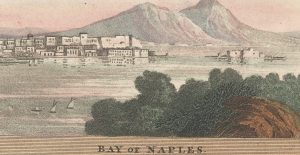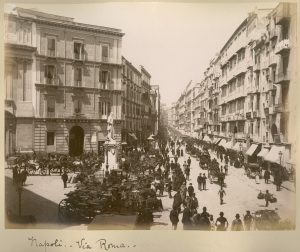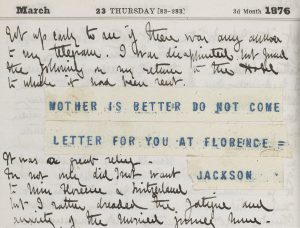December 17, 2024, by Chloe
Unearthing the Secrets of Vesuvius
It might nearly be Christmas, but today’s blog marks a holiday of a different kind as we continue to follow Dr Edward Wrench on his European tour in 1876. Last time we saw Dr Wrench, he had emerged from the Catacombs of the Capuchins at Rome, and, having satisfied his more superstitious impulses by drinking from the Trevi Fountain, he had left the Eternal City, heading south to Naples in search of the many archaeological marvels of Campania…
On arrival, he started his itinerary at the National Archaeological Museum at Naples, home to many of the artefacts and artworks recently dug up at Pompeii and Herculaneum, as well as those from the many Greek archaeological sites which are dotted around southern Italy. The museum was perhaps best known for its notorious ‘Secret Cabinet’, a collection of ancient art which was considered to be obscene and therefore kept under lock and key. Access was granted exclusively to educated gentlemen, who were considered to possess sufficient moral fortitude not to be unbalanced by the experience – in other words, men like Wrench. Interestingly, the doctor makes no reference to seeing anything of the sort in his diary, though he did make two separate trips to the museum, declaring ‘I am never tired of looking at the art and domestic life of old Pompeii’. Feel free to draw your own conclusions from that!
However, he showed considerably less enthusiasm for the excavations themselves. For instance, hardly a sentence is wasted on his trip to Herculaneum, which was little more than a stop-off before his trek up Vesuvius. His entire entry for the day was as follows: ‘Visited Herculaneum and Vesuvius. A most interesting day. We went with three horses in most gorgeous trapping. Started at 9 and at Resina about 10 and up there [Vesuvius] after seeing the theatre & ruins at 11’. Slightly confusingly, Resina was – at the time of Wrench’s visit – the name of the modern settlement lying atop the Roman town, though it would go on to be renamed Ercolano, the Italian translation of Herculaneum, a century later – the brainchild of some canny marketeer, no doubt.

Illustration of the Bay of Naples from Memoirs of Caroline, Queen Consort of Great Britain by J.H. Adolphus, Special Collection DA538.A2; 1821
It might seem strange that he devotes quite as much attention to equine accessories as he does to the excavations and appears to have spent only an hour at the site itself, but in his defence, it must be pointed out that the Herculaneum of the late 19th century would hardly be recognisable to modern eyes. Though over a century and half had passed since the rediscovery of the site, progress had been slow: since the original dramatic discovery – the theatre – only a few further houses had yet been uncovered, and their contents had for the most part been carried off to Naples. Wrench had even less to say on the subject of Pompeii, stating simply that it ‘was far more interesting and exciting than I had expected’ – which seems faint praise when it is taken into account that he dedicates the rest of that diary entry – a couple of pages in length – to discussing the quality of the road to Sorrento!
Shortly after his sojourn south, Wrench returned to Rome (perhaps the fountain water worked?) but his second visit was not destined to last long, as he found himself racing back to England via a surprisingly rapid route. Catch up with him next time to experience high-speed rail 19th century style, taking in breath-taking views of the Alps along the way…
In the meantime, why not make a booking to read Wrench’s diary for yourself in our reading room? To find out more, or to book an appointment today, please contact us at mss-library@nottingham.ac.uk.
No comments yet, fill out a comment to be the first



Leave a Reply